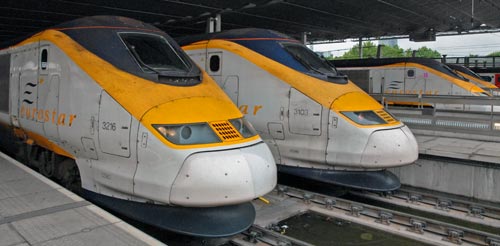London to Paris by Eurostar
Travel Date - 2010
The opening is St Pancras International for direct train services to Paris has been one of the greatest improvements in travel between the two cities for many years. Offering a city centre to city centre travel time of just over two hours, it is probably the most comfortable and quickest option.
The experience starts at the refurbished St Pancras station where a remarkable transformation has taken place. The main train shed was for many years the largest span in the world and this engineering masterpiece has been restored in all its glory. In addition the station hotel is currently in the final stages of restoration and once this is complete, travellers using the station will be able enjoy a Victorian building of particular architectural note.

Photo - The streamlined noses of Eurostar trains at London St Pancras.
There is a minimum check-in of 30 minutes for Eurostar trains and this means that you have to spend a while in the departure lounge. Here there are the usual shops and refreshments although at busy times of the day it can be a little crowded. Once the train is ready boarding passengers use escalators to take them up to the platform. With 18 coaches plus the two power cars, it takes a few minutes to walk the length of train. So it is worth making sure that you have identified which carriage your seat is located. You can then follow the appropriate signs which indicate the shortest route to your seat.
The journey started at 0932hrs on time. The first section of the trip is disappointing. There are no views of London landmarks or suburban life just the darkness of a tunnel as you begin to accelerate east out of London. A brief window of daylight means you are passing through Stratford where the 2012 Olympic Games will be held. Back into another tunnel and you emerge into an untidy landscape of factories, storage and distribution sheds, roads and other urban industrial clutter. You can see the M25 Motorway as it soars across the Thames before you burrow beneath the river to emerge in the County of Kent and Ebbsfleet station which passes in a flash.
Just 15 minutes from London you emerge into a more rural scene with fields and rolling hills. You may spot an old oast house that once drier hops but is most likely to be used as living accommodation these days. Over the River Medway, alongside a motorway where the traffic seems to be standing still. After speeding through Ashford the train starts to brake. Past the car and truck loading terminals and you disappear into darkness at a few minutes after 10a.m. Twenty minutes later you are in France.
The change is quite dramatic. Gone are the fields with hedges replaced with wide open spaces. Small villages consist of red pantiled houses crowded around an oversize church. There is little sign of life. The roads are empty and there is not a soul in sight. How the wind must whistle across these fields in winter. The scene looks very French, certainly from an Englishman's point of view. Even the electricity pylons seem to have some Gallic style. The train slows for Lille but soon accelerates as it turns south on the final run to Paris.
The wide open spaces contrast with the compact villages crowded around their churches. High speed trains flash by heading to Holland, Belgium, Germany and the UK. Small cemeteries by the line bear testimony to the horrors of two world wars. This is Picardie and the Somme. One wonders what horrors this landscape has seen in the previous century. Suddenly the wide open spaces are filled with factories, houses and Charles de Gaulle airport. We have reached the outskirts of Paris. We reduce speed and pass small stations with crowds lining the platform. There are neat rows of detached "maisons" some displaying elements of French Gothic architecture. There are railway yards and graffiti. More houses, apartments and graffiti. We slow for the last time as we enter Gare du Nord. The time is 12.47 - don't forget to add an hour to your watch. The train empties onto the platform. There are no passport formalities as they were done in London. The crowds spill into the main station concourse and go their various ways. If you have time have a closer look at the station. Like St Pancras this is one of the great railway terminals of Europe and its architecture reflects the hope and aspiration of the railway company that built it.
P.S. The journey back to London is much the same although the departure lounge at Paris is much more crowded than in London. The scenery is viewed from a different angle and you might spot things you missed on the outward trip. Oh yes, you can also briefly see London's skyline as you exit the tunnel under the Thames. Look out to left and you can see the high rise of Canary Wharf and central London. Then you disappear into the darkness to arrive at St Pancras with its light and airy train shed. The journey is complete!
Author - Lou Johnson